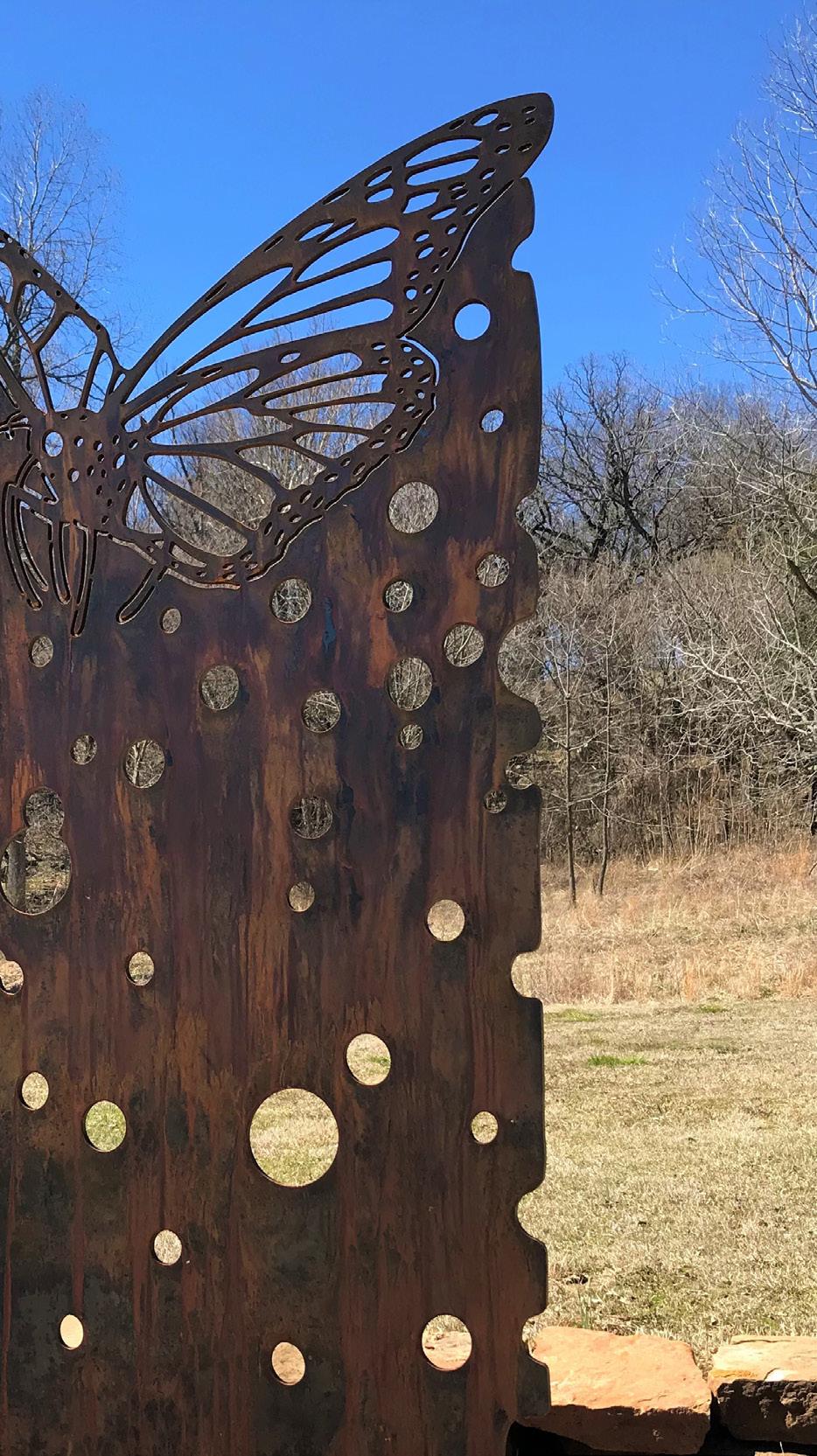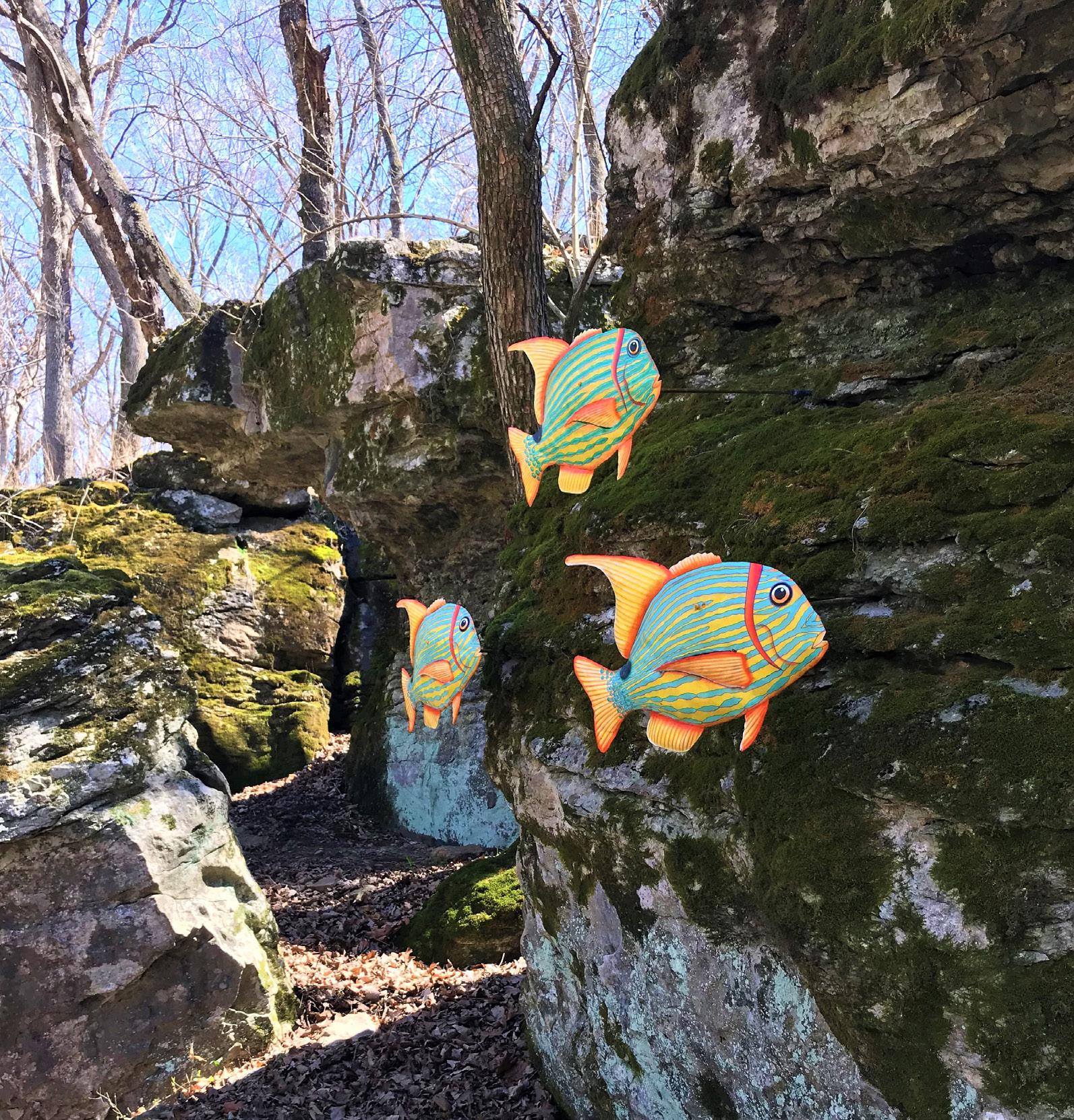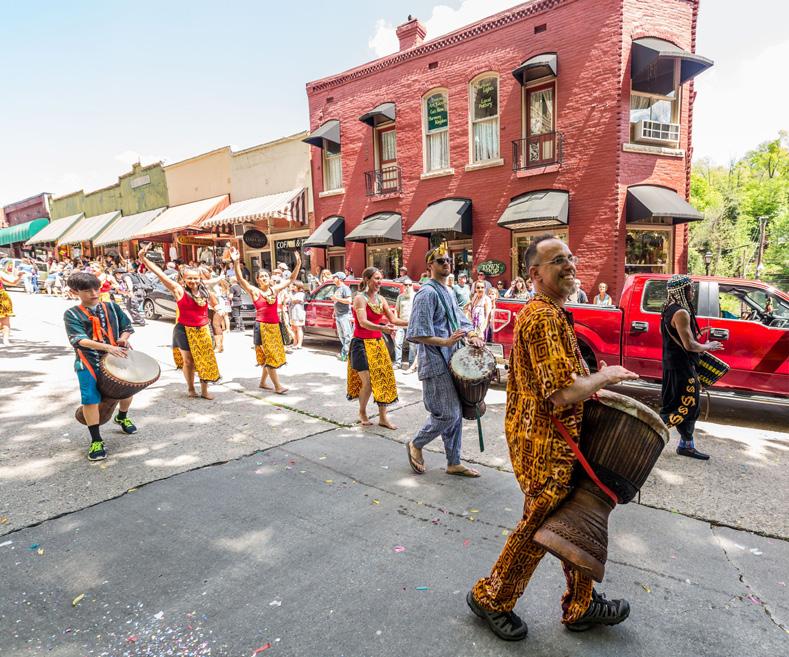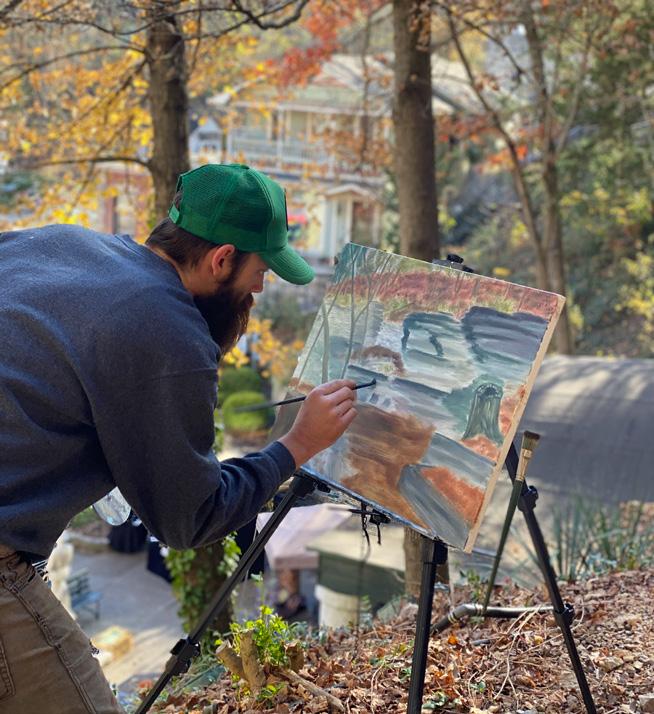
7 minute read
CULTURE
THE SMITHSONIAN COMES TO THE OZARKS
HISTORIC CANE HILL WELCOMES HABITATS.
BY CAROLINE MILLAR PHOTOGRAPHY COURTESY OF HISTORIC CANE HILL
THE FUNGUS AMONG US: Steel mushrooms, part of a traveling Smithsonian exhibit in Cane Hill through November, invite us to consider the complex, microscopic communication network under our feet.

DAY TRIP: At left, Cane Hill’s early 20th century fruit cellar brings local history to Smithsonian’s “Homes” portion of the outdoor exhibit. At center, blacksmith and sculptor Paul Siebenthal of Fayetteville created monarch and dragonfly sculptures especially for the Smithsonian exhibit. At right, tropical fish at Fossil Cove, seemingly suspended in mid-air, show this area was once an inland seabed. P reviewing a traveling Smithsonian exhibit recently provided a good excuse for a day trip to Cane Hill, a small rural community nestled in Washington County, 20 miles southwest of Fayetteville and a few miles east of Oklahoma. That such an exhibition would land here came as a surprise; but a leisurely day hike through a 4-mile wooded trail system and preserved historic grounds had my 11-yearold outdoors-loving son and me chanting the Smithsonian message, “Protecting Habitats Protects Life,” and left us pondering the natural and built heritage of this special place in the Arkansas Ozarks.
Cane Hill is the oldest settlement in Northwest Arkansas, built by pioneering families in the 1820s who were attracted to its natural springs and rich farming potential. In its heyday, the town was an epicenter of education, boasting the first public school and public library in the state and later the first college to accept female students. It also had a mill, a stoneware pottery and thriving apple orchards. Civil War enthusiasts may know the area for the Battle of Cane Hill in 1862, a prelude to the Battle of Prairie Grove. Today, a nonprofit, Historic Cane Hill, Inc., oversees the historic buildings of the town, 16 of which are on the National Register of Historic Places and many of which have been completely restored. But unless you’re a historic preservation nut, or ever had car trouble at this particular spot of state Highway 45, chances are you’ve never heard of this place.
Lawrence McElroy, director of arts and culture for Historic Cane Hill, sought the Smithsonian’s “Habitat” exhibit as a way to put Cane Hill on the map for day trippers. He also liked how it integrated art sculptures into the natural setting. For this flexible and build-it-yourself exhibition, the Smithsonian provides hosting organizations — which include nature centers, arboretums and botanical gardens — digital files of professionally designed graphic panels, and shop-drawings for three-dimensional sculptures, which hosts are free to incorporate into the trail system. Before “Habitat” came along, McElroy’s traditional role was to curate the museum’s historic collection and gallery space. “When I started this project, I didn’t realize what I would be doing is curating a trail system,” he said. McElroy relied on what he calls Cane Hill’s army of community support. “It’s not like [the exhibit] shows up on an 18-wheeler and they unpack it with, ‘Here’s everything you need.’ You’re pretty much starting from scratch,” he said.
After a three-hour drive from Little Rock, my son and I picnicked on a sunny lawn near the Cane Hill Gallery/Habitat Visitors Center, where I

picked up a trail map before setting out. Habitat can be accessed from any point, but I chose the bridge at Jordan Creek, newly constructed for the Smithsonian exhibit. From there, the Smithsonian’s nature-themed educational panels narrated the trail with themes like “A Log Called Home,” “Snug as a Bug” and “Dead Wood is Life” that urged us to consider the area’s ecology.
“Fossil Cove” is one of two stations that didn’t come from the Smithsonian. McElroy asked local experts to write specifically for Cane Hill. This panel points out that the limestone boulder under our feet was once an inland seabed. Crouching down with our noses to the rock, we found scores of 2-3-inch long, squiggly lines raised in relief form above the surface of the rockbed. These are fossilized stems of crinoids, a plant that once thrived in groves in the inland seabed, catching plankton with their many arms, McElroy explained. We also reached to feel the screwshaped circles that are Archimedes fossils, also called “moss animals,” that lived in the seabed for 77 million years. At this same stop, McElroy pointed to vines overhanging the bluff at Fossil Cove. Thanks to the help of Theo Witsell from the Natural Heritage Commission, he learned they’re wild grapes.
“Ozark Streams,” also written by local experts, highlights the non-finned critters that live in the free-flowing waters, such as the ebony damselfly, black and iridescent blue, which feeds on smaller insects at the surface of the water. We may return in August, when Dustin Lynch, with the Arkansas Natural Heritage Commission, will give a special program on crawfish diversity that includes stream snorkeling for crawdads.
Walking past a gurgling stream, we heard the soft, rhythmic sound of someone hand sawing through the distance in the woods. It was Christopher Scanga, a volunteer worker, finishing a new railing he built on a steeper section of the trail. Scanga temporarily moved to Cane Hill last fall from Maine with his wife, Deborah Schwartz; the couple live nomadically, choosing where to move each year based on the kind of volunteer projects they find. “The variety of this place is why Debbie and I are here,” Scanga told us, adding that he personally connected with the place. “I was raised on a farm in rural Pennsylvania — Appalachia — so a lot of what I see and feel around here is familiar to me. You know, extended Scotch-Irish families have been here for generations. I also love tools, and never had the chance to drive a 4x4 before.” Midday, Gretchen Crane, the third generation of a Cane Hill family, dropped by in a large moving truck with her husband, Daniel, to deliver a load of enormous wooden bug parts. Using the Smithsonian’s shop drawings, University of Arkansas at Fayetteville sculpture students cut the parts with a CNC (computer numerical control) router. Once painted and assembled, the sculptures — an 8-foot praying mantis and a 3-foot grasshopper — will be installed into a gnarly and dark canopy of beaux d’arc trees.
For Smithsonian’s “Nests,” McElroy is collaborating with a sculptor to create a humansized nest made of cedar sticks and found objects. “It’ll be a portal that looks into the habitat beyond,” McElroy said.
The outdoor exhibit opens April 16 and will be on display every day from sunrise to sunset until Nov. 26. I may return with the rest of my family later in the year to attend the educational Habitat programs scheduled this summer and fall, including a workshop on early 20th century farming in the Ozarks, a nature writing workshop from UA writing faculty, a lecture by a UA entomologist on five insects and their impact on human history, and an archeology day with the UA’s Arkansas Archeological Survey, which will highlight early 19th century production of pottery in the area. Details can be found at historiccanehillar.org.

SPONSORED CONTENT The 35th Annual May Festival of the Arts in Eureka Springs



To say that Eureka Springs is a colorful community is an understatement. There’s a creative vibe running through our historic arts village driven by more than 350 working artists across mediums. During the month of May, we show it all off. The 35th Annual May Festival of the Arts is packed with one-of-a-kind art exhibits, the ARTrageous parade, demonstrations, performances, culinary arts, free music in the park, and the wildest street party thrown by artists – the White Street Walk.
The ARTrageous Parade — 2 p.m. Saturday, May 7, is the place to express your inner creator and truly be yourself! The parade is the customary kickoff to the May Festival of the Arts, an annual citywide extravaganza of imaginative events throughout the entire month of May. There will be music, performances, parade floats, and a chance to win cash and prizes based on your costume, performance, or float! Keep in mind that to be eligible for prizes you must fill out a parade entrant application by April 24, found on the web site below. You can return it via snail mail, email, passenger pigeon or however you like!
DON’T MISS THESE OTHER EVENTS: Drummers in the Park May 16 White Street Art Walk May 20 Eureka Springs Plein Air Festival

BLUE SPRING HERITAGE CENTER
Come see the extraordinary beauty and rich cultural experience of the Blue Spring Heritage Center. Visit the historic bluff shelter, now on the National Register of Historic Places. Walk on ground that nurtured the Cherokee people in the time of the Trail of Tears. Connect with the natural beauty of our many native gardens. See the power and wonder of Blue Spring, pouring 38 million gallons of cold, clear water each day into its trout-filled lagoon. Come discover the land of blue skies and laughing water.
Blue Spring Heritage Center 1537 Co Rd 210, Eureka Springs, AR 72632 www.bluespringheritage.com 479.253.9244








